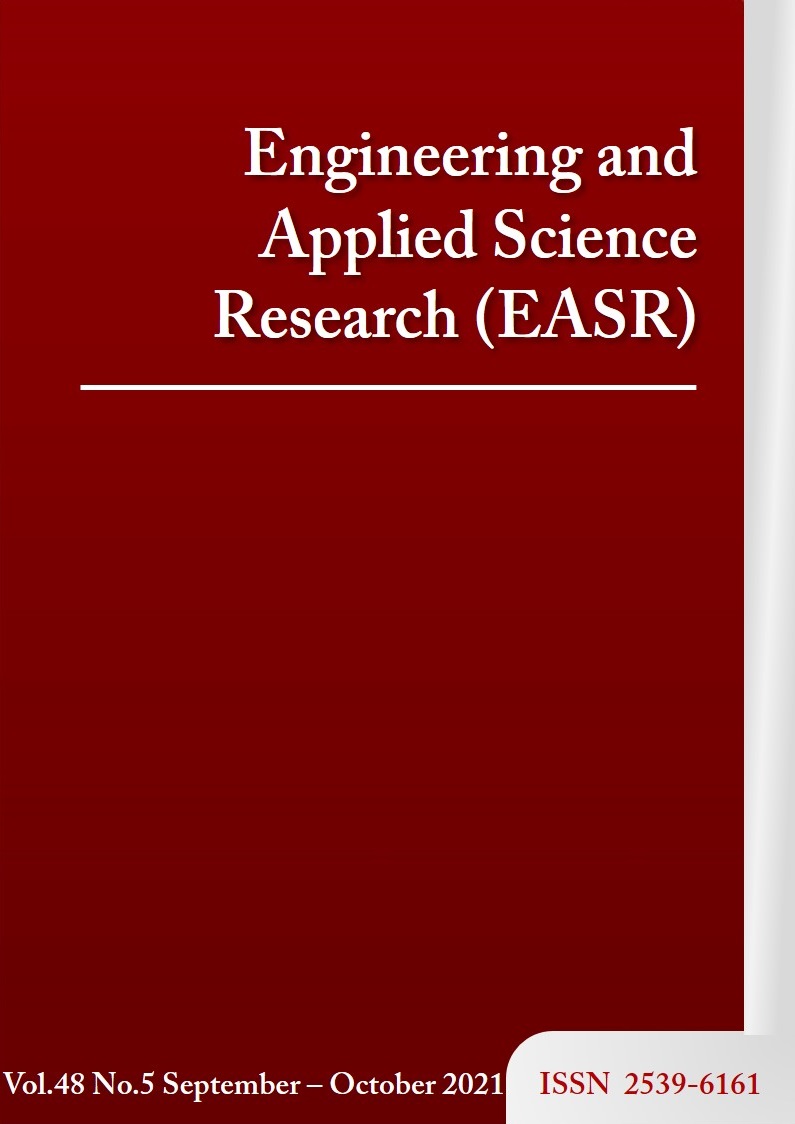Fast obstacle detection system for the blind using depth image and machine learning
Main Article Content
Abstract
Our research proposes a novel obstacle detection and navigation system for the blind using stereo cameras with machine learning techniques. The obstacle classification result will navigate users through a difference directional sound patterns via bone conductive stereo headphones. In the first stage, the Semi-Global block-matching technique was used to transform stereo images to depth image which can be used to identify the depth level of each image pixel. Next, fast 2D-based ground plane estimation which was separate obstacle image from the depth image with our Horizontal Depth Accumulative Information (H-DAI). The obstacle image will be then converted to our Vertical Depth Accumulative Information (V-DAI) which was extracted by a feature vector to train the obstacle model. Our dataset consists of 34,325 stereo-gray images in 7 different obstacle class. Our experiment compared various machine learning algorithms (ANN, SVM, Naïve Bayes, Decision Tree, k-NN and Deep Learning) performance between classification accuracy and prediction speed. The results show that using ANN with our H-DAI and V-DAI reaches 96.45% in obstacle classification accuracy and 23.76 images per second for processing time which is 6.75 times faster than the recently ground plane estimate technique.
Article Details
This work is licensed under a Creative Commons Attribution-NonCommercial-NoDerivatives 4.0 International License.
References
WHO. Draft action plan for the prevention of avoidable blindness and visual impairment 2014-2019: universal eye health: a global action plan 2014-2019. Geneva: World Health Organization; 2013.
Clark-Carter DD, Heyes AD, Howarth CI. The efficiency and walking speed of visually impaired people. Ergon. 1986;29(6):779-89.
Loomis JM, Golledge RG, Klatzky RL. GPS-Based navigation systems for the visually impaired. In: Barfield W, Caudell T, editors. Fundamentals of wearable computers and augmented reality. New Jersey: Lawrence Erlbaum Associates; 2001. p. 429-46.
Ritz M, Konig L. Laser technique improves safety for the blind. MST NEWS. 2005;5:39.
Inc NRI. The laser cane, model N-2000 [Internet]. 2020 [cited 2020 Sep 20]. Available from: http://www.nurion.net.
Ulrich I, Borenstein J. The guide cane-applying mobile robot technologies to assist the visually impaired. IEEE Trans Syst Man Cybern Syst Hum. 2001;31(2):131-6.
Research G. The miniguide mobility aid [Internet]. 2020 [cited 2020 Sep 20]. Available from: http://www.gdp-research.com.au/minig_1.htm.
Ito K, Okamoto M, Akita J, Ono T, Gyobu I, Takagi T, et al. CyARM: an alternative aid device for blind persons. Extended abstracts proceedings of the 2005 conference on human factors in computing systems; 2005 Apr 2-7; Portland, USA. New York: Association for Computing Machinery; 2005. p. 1483-8.
Vorapatratorn S, Nambunmee K. ISonar: An obstacle warning device for the totally blind. J Assist Rehabil Ther Tech. 2014;2(1):23114.
Damaschini R, Legras R, Leroux R, Farcy R. Electronic travel aid for blind people. In: Pruski A, Knops H, editors. Assistive technology: from virtuality to reality. Amsterdam: IOS Press; 2005. p. 251-5.
Vorapatratorn S, Suchato A, Punyabukkana P. Real-time obstacle detection in outdoor environment for visually impaired using RGB-D and disparity map. Proceedings of the international convention on rehabilitation engineering & assistive technology; 2016. p. 1-4.
Kumar AD, Karthika R, Soman K. Stereo camera and LIDAR sensor fusion-based collision warning system for autonomous vehicles. In: Jain S, Sood M, Paul S, editors. Advances in computational intelligence techniques. Singapore: Springer; 2020. p. 239-52.
Gao H, Cheng B, Wang J, Li K, Zhao J, Li D. Object classification using CNN-based fusion of vision and Lidar in autonomous vehicle environment. IEEE Trans Ind Informat. 2018;14(9):4224-31.
Catapang AN, Ramos M. Obstacle detection using a 2D LIDAR system for an autonomous vehicle. 2016 6th IEEE International conference on control system, computing and engineering (ICCSCE); 2016 Nov 25-27; Penang, Malaysia. New York: IEEE; 2016. p. 441-5.
Li B, Zhang X, Munoz JP, Xiao J, Rong X, Tian Y. Assisting blind people to avoid obstacles: an wearable obstacle stereo feedback system based on 3D detection. 2015 IEEE International conference on robotics and bio mimetics (ROBIO); 2015 Dec 6-9; Zhuhai, China. New York: IEEE; 2015. p. 2307-11.
Rodriguez A, Yebes JJ, Alcantarilla PF, Bergasa LM, Almazan J, Cela A. Assisting the visually impaired: obstacle detection and warning system by acoustic feedback. Sensors. 2012;12(12):17476-96.
Correal Tezanos R. Stereo vision-based perception, path planning and navigation strategies for autonomous robotic exploration. Madrid: Universidad Complutense de Madrid; 2015.
Emani S, Soman K, Variyar VS, Adarsh S. Obstacle detection and distance estimation for autonomous electric vehicle using stereo vision and DNN. In: Wang J, Reddy G, Prasad V, Reddy V, editor. Soft computing and signal processing. Singapore: Springer; 2019. p. 639-48.
Guindel C, Martin D, Armingol JM. Traffic scene awareness for intelligent vehicles using Conv Nets and stereo vision. Robot Autonom Syst. 2019;112:109-22.
Stereolabs. ZED stereo camera [Internet]. 2020 [cited 2020 Sep 20]. Available from: https://www.stereolabs.com/zed/.
Inc A. iOS Device Capture Format Specifications [Internet]. 2020 [cited 2020 Sep 20]. Available from: https://developer.apple.com/library/archive/documentation/DeviceInformation/Reference/iOSDeviceCompatibility/Cameras/Cameras.html.
AZOROBOTICS. PCI nDepth™ Vision System from Focus Robotics [Internet]. 2020 [cited 2020 Sep 20]. Available from: https://www.azorobotics.com/equipment-details.aspx?EquipID=467.
Ltd VSP. The Bumblebee®2 stereo vision camera [Internet]. 2020 [cited 2020 Sep 20]. Available from: https://www.voltrium.com.sg/en/cameras/machine-vision-cameras/stereo-products/bumblebee2.
Design V. MEGA-DCS stereo head [Internet]. 2020 [cited 2020 Sep 20]. Available from: http://users.rcn.com/mclaughl.dnai/sthmdcs.htm.
Cochran SD, Medioni G. 3-D surface description from binocular stereo. IEEE Trans Pattern Anal Mach Intell. 1992;(10):981-94.
The MathWorks I. Jet colormap array [Internet]. 2020 [cited 2020 Sep 20]. Available from: https://www.mathworks.com/help/matlab/ref/jet.html.
The MathWorks I. Classification Learner [Internet]. 2020 [cited 2020 Sep 20]. Available from: https://www.mathworks.com/help/stats/classificationlearner-app.html.
Jain AK, Mao J, Mohiuddin KM. Artificial neural networks: a tutorial. Comput.1996;29(3):31-44.
Hearst MA, Dumais ST, Osuna E, Platt J, Scholkopf B. Support vector machines. IEEE Intell Syst appl. 1998;13(4):18-28.
Murphy KP. Naive bayes classifiers. Vancouver: University of British Columbia; 2006.
Safavian SR, Landgrebe D. A survey of decision tree classifier methodology. IEEE Trans Syst Man Cybern. 1991;21(3):660-74.
Keller JM, Gray MR, Givens JA. A fuzzy k-nearest neighbor algorithm. IEEE Trans Syst Man Cybern. 1985;(4):580-5.
Krizhevsky A, Sutskever I, Hinton GE. Imagenet classification with deep convolutional neural networks. Adv neural inform process syst. 2017;60(6):84-90.



